Petrol engines initially offered at launch were a
1581cc sohc (90bhp) and a 1995cc dohc (120bhp), both being fitted with fuel injection whilst the latter also had twin
contra-rotating balancer shafts in the block. These were flanked by a 1929cc turbodiesel (90bhp). Shortly afterwards, in October 1989, a 1756cc dohc (110bhp) petrol
unit was added.
In 1990 two further models were added to
the range - the 'Dedra 2000 turbo' which used a 1995cc turbocharged dohc
engine producing 165bhp, and the 'Dedra Integrale' which had four wheel
drive and a similar engine slightly more tuned to produce 180bhp. These
models were also fitted with slightly different external trim, bumpers, fog lights and spoilers. Combining comfort and performance these
cars continued the best of the Lancia tradition. Further additions came in the shape of an eco 1.9 turbo diesel later in 1990 and then in 1992 a four-speed automatic
transmission, available with the 2.0ie engine.
An all new model, an estate called the Dedra SW (for Station Wagon), was introduced
in 1994. The engines were the same as the saloon, which were revised to
include a 90bhp multi-point fuel injected 1600 (previously it had been a single-point
fuel injection unit), and a 16v version of the 2000 engine (139bhp). The
latter replaced the 2000 turbo which was dropped from the range. With the discontinuation of the four wheel drive saloon the options were 1.6 and 1.8 in both saloon and estate body,
2.0 auto saloon, 2.0 16v saloon and estate, 2.0 16v integrale estate and turbodiesel saloon and estate. Trim levels became three, LE, LS and LX. Again trims changed as did a
variety of other details.
The engines were again revised in 1996
when two new 1800 engines were introduced. Actually 1747cc, these produced
113bhp in the normal version, and 130bhp with variable valve timing. Finally
in 1998 the 1600 unit gained 16v (103bhp) just before production of the
Dedra stopped in 1999 when it was replaced by the Lybra.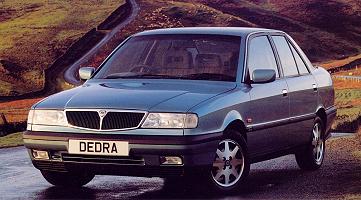 Launched in the spring of 1989, the Dedra was developed alongside the Fiat Tempra
on the Tipo floorpan as a medium size three-box saloon.
The design, by the IDEA studio, of the four door body produced an excellent
drag coefficient of only 0.29. The core of the product was prestige, exclusivity, personality and comfort, achieved through a high level of equipment and use of materials
(eg Alcantara) as well as details such as special paints, alloy wheels etc and an attention to soundproofing, ventilation and other issues.
Inside the ability to obtain the perfect driving position was helped by the adjustable seats, steering wheel, electrically adjustable mirrors etc.
Safety, both passive with a structure designed to minimise injury in an accident, and active, such as ABS, was also near the top of the Dedra's agenda.
Launched in the spring of 1989, the Dedra was developed alongside the Fiat Tempra
on the Tipo floorpan as a medium size three-box saloon.
The design, by the IDEA studio, of the four door body produced an excellent
drag coefficient of only 0.29. The core of the product was prestige, exclusivity, personality and comfort, achieved through a high level of equipment and use of materials
(eg Alcantara) as well as details such as special paints, alloy wheels etc and an attention to soundproofing, ventilation and other issues.
Inside the ability to obtain the perfect driving position was helped by the adjustable seats, steering wheel, electrically adjustable mirrors etc.
Safety, both passive with a structure designed to minimise injury in an accident, and active, such as ABS, was also near the top of the Dedra's agenda.
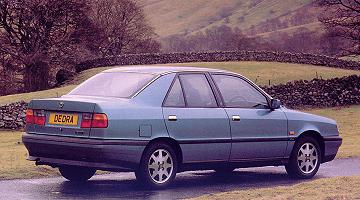 The range was rationalised and further improved in 1992 with the introduction of four trim levels, the Comfort, LE, LS and HF. These grouped the most commonly
requested options together, along with some new fabrics and interior colours. Seat and seatbelt mounting points were modified, some instruments added and other minor
changes (tinted glass, badging) made. By late 1992 around 264,000 Dedra's had been sold.
The range was rationalised and further improved in 1992 with the introduction of four trim levels, the Comfort, LE, LS and HF. These grouped the most commonly
requested options together, along with some new fabrics and interior colours. Seat and seatbelt mounting points were modified, some instruments added and other minor
changes (tinted glass, badging) made. By late 1992 around 264,000 Dedra's had been sold.
Technical Details
| Driveline | transverse engine at front with front wheel or four wheel drive |
| Engines | 1581cc (86.4x67.4mm) sohc four cylinder with 90bhp @ 5,800rpm (image)
1756cc (84x79.2mm) dohc four cylinder with 110bhp @ 6,000rpm 1995cc (84x90mm) dohc four cylinder with 120bhp @ 5,750rpm (image) 1995cc (84x90mm) dohc turbocharged four cylinder with 165bhp (2WD) or 180bhp (4WD) @ 5,500rpm 1929cc sohc turbodiesel four cylinder with 90bhp (image) |
| Suspension | front : MacPherson strut with telescopic dampers and coil springs plus anti-roll bar
rear : independent with telescopic dampers and coil springs Electronically controlled damping available as an option on some versions Wheelbase : 2540mm track (front/rear) : 1436mm/1415mm |
| Brakes | front : discs
rear : drums (or discs on some versions) handbrake operating on the rear via a cable ABS (optional on some models) |
| Gearbox | 5 speed manual
4 speed automatic |
| Steering | Rack and pinion (hydraulically power assisted on some models)
3.0 turns lock-to-lock (except without PAS in which case 3.75 turns) |
| Dimensions | click here. |
| Weights | 1.6ie : 1060kg ; 1.8ie : 1150kg ; turbo ds : 1200kg ; 2.0ie : 1170kg |
Performance
| model | max speed | 0-100km/h | standing km | Braking (from 100km/h) |
| 1.8ie (1990) | 192 km/h | 10.2 sec | 31.9 sec | 41 m |
| 2.0ie (1989) | 198 km/h | 10.4 sec | 31.7 sec | 44.4 m |
Tuning
There are three main areas to concentrate on, the engine (and transmission), the brakes and the suspension and then various other details. These three should be done together since they complement each other, not all of one and none of another !
1. The engine.
Before modifying the engine it is worthwhile filling it with a good quality synthetic oil and fitting new spark plugs. An engine oil additive may also be used.
The first improvements are relatively simple.
The air filter can be replaced for an aftermarket item which will help
the engine breathe more freely, the type which completely replace the original
airbox are best, and the exhaust can be replaced for one which will restrict
the exit of the gases less. The whole system should be replaced, not just
the rear section.
On turbocharged models the boost pressure
can be raised to increase the power, not too far or the fuelling will not
be able to cope and the engine will run weak. Water spray on the intercooler
is also worth considering, switched by either an air temperature sensor
(the ideal solution) or bay a MAP sensor (the easy solution). Consider
also adding an octane boosting product to the fuel on cars with increased
boost levels, it will help the ignition cope.
Other things to do should include fitting
a cold air intake, a large diameter pipe (minimum 5cm) to provide air from
outside the engine bay to the air filter. The exhaust manifold can also
be lagged with thermal cloth or tape to keep the exhaust gases hotter (and
thus reduce back pressure) and also to keep the underbonnet (and hence
intake and fuel) temperatures lower.
Further modifications require the machining
of the cylinder headand/or cylinder block (which will not be dealt with
here since it is not normally a DIY job) after which it may be worth fitting
an oil cooler. If overheating is a problem due to the increased power output
then a small hole can also be drilled through the plate in the thermostat.
There are a multitude of company's with experience of internal cylinder
head modifications for the Lancia twin cam engine so it should be possible
to find one wherever you are.
Regarding the transmission the main requirement
is to uprate the clutch to handle the increase in power and torque achieved
though the engine modifications. Friction plates can be purchased with
improved materials and heavier duty pressure plates are also available.
Whilst doing this it is worthwhile lightening the flywheel.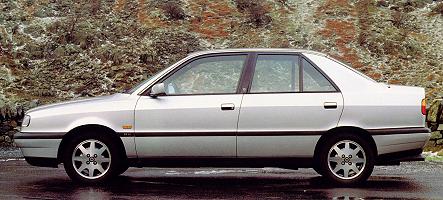 The
most effective modification (short of engine rebuilds!) is probably to
replace the electronic control unit (or 'chip'). A variety of these are
available, but all should increase the power and improve the driveability.
The downside is that these usually cancel the warranty and may affect the
durability of the engine, the emissions and the fuel consumption. If one
is not available for your specific model it is possible to buy a general
one for any car and program it.
The
most effective modification (short of engine rebuilds!) is probably to
replace the electronic control unit (or 'chip'). A variety of these are
available, but all should increase the power and improve the driveability.
The downside is that these usually cancel the warranty and may affect the
durability of the engine, the emissions and the fuel consumption. If one
is not available for your specific model it is possible to buy a general
one for any car and program it.
The high tension leads can also be replaced
with performance ones.
2. The brakes.
Initially it is relatively easy to replace the brake discs with drilled and grooved items, and the pads for a harder compound. The latter should not be too hard (ie no race pads on the road) or they will not function effectively at the normal 'road' operating temperatures. Stainless steel braided flexible hoses will improve the pedal feel and reduce the chance of damage whilst DoT5 fluid (not silicon) will increase the temperature at which it can operate effectively. If the brakes are getting too hot the dustguards can be removed and/or ducts fitted, taking air from behind the front bumper.
If more serious braking is required the next modification would be to increase the disc size. It is possible to use larger discs with a bracket allowing use of the production callipers, or alloy four pot callipers can be fitted.
In order to improve the balance of the car under braking it is desireable to be able to adjust the balance of braking from front to rear (and vice versa). This can be accomplished by fitting a bias valve in the line to the rear brakes, usually in a position so that it can be reached from the drivers seat.
3. The suspension.
The easiest improvement,and the one which
will probably bring the single most noticeable change, is to replace the
dampers and There are then two other main suspension
aims; to reduce the flexiblity in the suspension and to increase the stiffness
of the car, both of which aim at more accurate control of the wheel movement.
To reduce the flexibility it is possible to fit nylon bushes instead of
the normal production rubber items, or if perfection is desired the suspension
can be fitted with metallic bearings (rose joints / rod ends). Spherical
bearing top mounts can also be used. To stiffen the car it is most popular
to fit strut braces. These can be fitted to the front and rear. For more
extreme cases a rollcage can be fitted.....
Into this category also fall the choice
of wheels and tyres. With an increase in power it can be necessary to fit
larger tyres (thus requiring larger wheels) but the temptation to fit the
biggest possible should be resisted. Consideration should be given to fitting
a wider tyre on the front (since they provide traction and steering) but
keeping the standard, or a wider but not as wide as the front, tyre at
the rear. This will improve the balance of the car. On the four wheel drive
models the same size all around can be the best solution.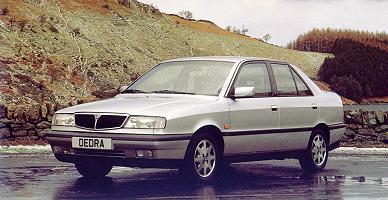 springs.
Fitting lowered springs will improve the cornering, but must be fitted
together with shortened throw dampers, or else the springs may unseat !
Top adjustable dampers are compromised, but are good for road and track
day cars since it allows the suspension to be adjusted between these two,
rather different, requirements. Coil over units add more adjustability
and can be purchased outright, or can be made from standard dampers by
welding a threaded sleeve to the standard tube.
springs.
Fitting lowered springs will improve the cornering, but must be fitted
together with shortened throw dampers, or else the springs may unseat !
Top adjustable dampers are compromised, but are good for road and track
day cars since it allows the suspension to be adjusted between these two,
rather different, requirements. Coil over units add more adjustability
and can be purchased outright, or can be made from standard dampers by
welding a threaded sleeve to the standard tube.
4. other things.
Other modifications worth considering include fitment of a shift light (and rev limiter if there is not one as standard), higher power bulbs in the headlights (if you are going to go faster you need to see further) and installation of a quicker steering rack.
Buying / Selling
Some tips to do before selling :
(they may seem obvious, but most people don't do them and thus are in a
weaker bargaining position)
Tidy inside the car thoroughly : hoover
the floor, empty all pockets, ashtrays (wash), glove compartment etc...,
wipe the trim with a damp cloth, give the cockpit a good airing to get
rid of any odours ! Reset the trip meter to 00000 - it is a pleasant (subconcious)
'Back to black' products are very effective
at temporarily restoring bumpers and trim. This makes a big difference
to any car. Do it a week before you expect people to view the car, otherwise
it may be a bit too obvious !
Jetwash under the car, especially under
the engine and in the wheelarches. The prospective buyer may be an enthusiast,
and this makes it easier for them to see what they want to check.
Obviously wash the car and clean the windows !
If you are going to buy a car always
check the following :
Firstly check the bodywork. Check that
there are no mismatching panels, large areas of discolouration or signs
of fresh paint (compare inside the engine bay with the external body colour),
all of which probably indicate accident damage.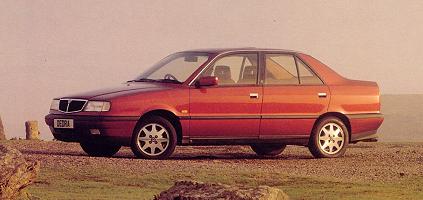 surprise.
If the car has been standing give it a
good run - this will clear out the engine (reduce exhaust smoke), put a
shine on the brake discs and loosen up any joints that may otherwise make some noises.
surprise.
If the car has been standing give it a
good run - this will clear out the engine (reduce exhaust smoke), put a
shine on the brake discs and loosen up any joints that may otherwise make some noises.
Check the main electrical functions - wipers, windows, lights, etc... try putting the main beam and wipers on at the same time. Check the headlights for cracks.
Check the brake pedal does not go to the floor if pressed hard for a long time and check the gearchange for clean engagement.
The engine should be run up to temperature,
check the exhaust for smoke (especially on turbo models), the condition
of the breather (look for mayonnaise), the condition of the oil filler cap
(again white deposits can indicate head gasket or other serious problems
or the use of the car only on short journeys, another bad state of affairs)
and the colour of the coolant (preferably not thick or dark brown!). Listen
to the noise of the engine, then depress the clutch and engage first gear.
Whatever noise has disappeared was coming form the gearbox, what remains
is from the engine. Also check the condition of the engine oil on the dipstick.The
lighter brown the better, if it is thick black then leave quickly.
Check tyre wear, uneven patterns could
imply a bent chassis.
Always take it for a test drive. Check
that the car tracks in a straight line with no steering input and also
remains straight under braking. Find a large open area and complete several
lock to lock turns (also in reverse), listening for any noises. Try the
handbrake when moving - seized rear callipers will mean uneven braking or no braking.
For books on Lancia see our Online Bookstore
There is also a list of all our picture galleries (including museums, motorshows and various events).
Wallpapers/Desktop Backgrounds of numerous Lancia's, including the Dedra, are available to download.
See also our Lancia advertisements gallery, where several adverts can be seen.
Dedra comment form
Your Comments
I have a Dedra(SE) ie Turbo
1991 which seems to be a fairly rare car in the UK? It is in superb condition
and an absolute joy to drive. Even compared to some more modern performance
cars. 165.500 miles with just a reconditioned gearbox! (Paul, UK)
Hi im Glenn from SW England
and own a 1.8ie Dedra 1990 67k in mint condition. I think these cars are
seriously underrated and a classier alternative to the Alfa 155.
Beautiful car. It really
is underrated, and i am happy to own one. It is a 1992 model 2.0i.e. in
metallescente black. (Dirk, Germany)
Hi this is Simon from Manchester.
I am a product designer and believe the Dedra is a well design car with
crisp lines and nice details .The interior is also well though out with
its stylish dashboard .It also has interesting features such as a plastic
cover underneath the rear end to aid aerodynamics .I own a 2.0 ie and have
carried out various modifications, which are quite easy to do .First I
have fitted a comp air filter and air intake duct,Supersprint exhaust,Tarrox
discs,Sparco strutbrace,and Eibach spings.These changes have greatly improved
the cars performance,and on a very quiet remote road i couldn't believe
it when I managed to hit 140mph, I am not a boy racer honest !
I own a Dedra 1.9tds 1995,
it has more than 300.000Km with only one engine revision, it still kicks
BMW's ass. It is a great piece of machine, it has eated up many kilometers
of tarmac. And yes, i kick some ass while i drive it!
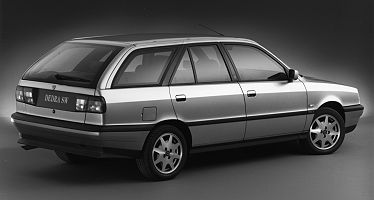 I own a 92 Dedra HF Integrale - greate car. Fast - awesome handling and killer looks. Greate for winter driving. (SiSt, Norway)
I own a 92 Dedra HF Integrale - greate car. Fast - awesome handling and killer looks. Greate for winter driving. (SiSt, Norway)
I have a 2.0 16V Dedra (1996),
Its an excellent car, very comfortable and fast, on the road it goes so
good but I have to check and also change the cambelt every 20.000 km, on
the 16V its important to do that becouse the belt work so hard....Octavio (Colombia)
I may be the owner of a Dedra 2000 HF Turbo, she loves to be driven very hard. And I give it to her over
and over again. I don't understand that everybody is driving a Opel or
something like that. What's about love..... a LANCIA you most love. (Erik-Jan, Netherlands)
I have a Dedra Integrale 1992.
I have owned a 2.0ie CP Dedra
for ten years. It has now covered over 217,000 miles on the original engine
and transmission and still runs very smoothly. It is very hard indeed
to think of a replacement for such a reliable, stylish and unusual car.
If only the Lybra were to be available here! (Martin G, UK)
I am the owner of a Dedra 1.6 '92 model. it currently holds 115.000 Km. I think that although it had few problems and is
not fast enough, it is an excellent car for travelling with TOP handling and road behaviour. I really enjoy driving it and I
am intending to keep it for a lot more years. My next car will be a Lybra or thessis of course! (Greece)
Hi, I bought a 1990 Lancia Dedra 1.6ie yesterday and even though the car is old and it has 275.000! !km behind it it still
feels like a new one. NO WEAR AND TEAR anywhere! and no rust + all the electrical systems are working too.. it's enjoyable
to drive and i really like the car's silence and stability just like in more expensive cars, even my friends who drives a 1989
BMW 750 series car is now thinking of buying his girlfriend a Lancia. (Nelson, Finland)
My name is Gus (UK), and I have owned a 1991 2.0lt Dedra turbo for
six months. What can I say, 160,000m, standard, and still sounds and drives like new. I love it!
I have just bought a Dedra 2.0ie 1993 for £750.00. The car has done 75000 mls. It looks and drives great. Well impressed! Unbelievable value. (Dave. UK)
I'm the owner of a Dedra 1.8 IE '92 car for six years now and I always enjoy driving it cause I love it's design but also the temper of it's engine. I only didn't like it's fuel consumption (11 liters/100 km) and so I made it run on LPG (Liquid Petrol Gas)
The nice result was an even better performance for a cheaper fuel price... (Marc, Belgium - A real fan of Italian cars)
I have Dedra turbo(91)I've had many cars but i consider Dedra to be the best, fastest and the most excellent driving one.
I bought it from Germany driven 160000km and taken much care of.A year has passed and i never want to sell it ! There are 3 to 5 models like this in our country.
The funny thing is that the prize of it is rising all the time. You really can't compare Lancia to Audi or MB. Dedra's got more style, speed and impression. I'm really satisfied. (Bill, Estonia)
My Dedra is 2.0 TDS,95;I am first owner and im really satisfied with her.Superb engine for 92 BHP it is better than all kinds of TDIs,CDIs...It is fast,
fun to drive,comfortable car...I just LOVE TURBO!!!All cars after Dedra are boring and anoying...BEST BUY. (Ante, Croatia)
I own a 1991 dedra 2.0ie it is the best car i have ever owned. it has done 115000miles and is still going strong.it has performance
exhaust,16"alloys and lowered suspention.i also have a dedra 1.8ie patientley waiting for a engine. (Matt, UK)
I had a Dedra 1.6ie 1995 in Singapore. Maybe it is just a car, but it had been my 'friend' and my pride driving her around.
But, cars are expensive in sg, and there is limitation to ownership. Now, she is gone, I just have to say that I miss my Dedra very much. (Wilkie R.T.)
I fall in love with a wonderfull toy, the 2000ie. she's mine since September 2001, but in my heart since 1991. what a pleasur when
dreams comes true. Her name reflect the truth High Fidelity (HF) very fast and confortable but somtimes too hungry... (Greg, France)
I have a DEDRA since 1992 .Just great car . I love it . Is 1.6 ie with 225.000 km now...still look wonderfull & '' new'' .Love to drive it & enjoy it too. I still kick some
asses on road with curves...LANCIA 4EVER.... Wish i had the 2.0integrale version....never mind.....the new delta HPE is coming.....(Meletis, Greece)
GOOD : Nice car. A
lot of quality. Beautiful body, good power, excellent road handling. Very
great for trip at high speed, in all weathers.
BAD : the car isn't very
strong : engine and some other components haven't the strength that you
may expect for this type of car. The 2,0 litres DOHC Turbo overheats frequently.
2 engines and 1 head gasket in 75000 km !!!. And for now I must replace
the turbo. (W.L, France)
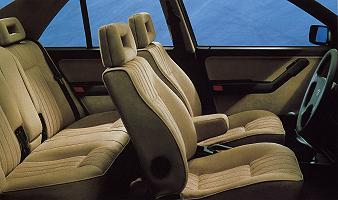 Lancia DEDRA is fine car. It is very comfortable and safe vehicle. (Dubravko, Croatia)
Lancia DEDRA is fine car. It is very comfortable and safe vehicle. (Dubravko, Croatia)
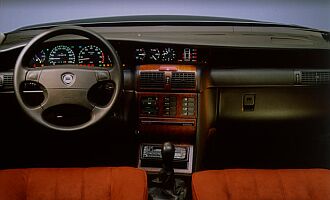
Use
the buttons at the top to navigate further, or
Copyright © 2000 to 2008 CarsfromItaly